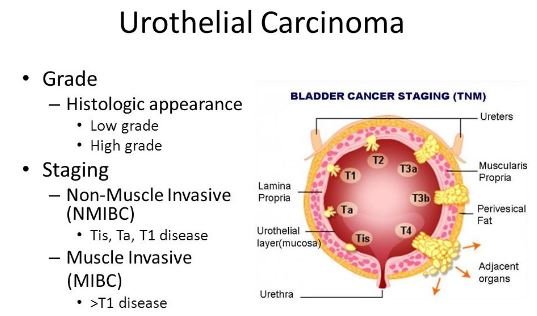What is urothelial carcinoma?
Urothelial carcinoma include carcinomas of the renal pelvis, bladder and ureters. The incidence rate is not very frequent, but the most usual affected part is bladder and renal pelvis affected less frequently. In 10% cases, the bladder carcinoma can spread to renal pelvis and 5% in ureters.

The risk of onset of the urothelial carcinoma is increased with age. The peak rate of onset is in between 70 to 80 years of age. Urothelial cancer is more common in man than female. Fair Western population have two times greater risk to develop urothelial cancer than Negros. (1,2)
Etiology & risk factors
- Renal papillary necrosis is one of the prime anomaly, the outcome can be converted to urothelial carcinoma. The renal medullary pyramids and papillae is affected with renal papillary necrosis (RPN), which is caused by tissue necrosis due to clotting disorder. This condition is associative with another disorder and accumulation of the toxins that exhibit additive effect to develop the ischemia.
- Drinking excessive coffee or tobacco smoking can increase the chances of urothelial carcinoma due to accumulation of toxins. Prolong use of Phenacetin can stimulate nephropathy and increase the risk of urothelial carcinoma.
- Chronic renal infection may also influence the development of the squamuos cell carcinoma and a smaller chance of conversion to the adenocarcinoma, which affects upper urinary tract.
- The workers who working in the petrochemical, plastic, and tar industries are repetitively exposed to the petrochemical, plastic, and tar and has an increased risk of urothelial carcinoma.
- A chemotherapeutic agent like cyclophosphamide is increasing the risk factor of urothelial tumors and high degree association with urothelial carcinoma.
- Balkan nephropathy is linked with degenerative interstitial nephritis and is another cause of urothelial carcinoma. But the tumor allied with Balkan nephropathy are multiple and causing low grade urothelial carcinoma in comparison with other risk factors.
- Genetic abnormality can also contribute to urothelial carcinoma, if it is associated with Lynch syndrome type II. (2)
Also read – Genetic DNA Testing For Cancer, Top 40 Cancer Fighting Foods
Grading
Staging is a mode of relating the location of the cancer if or to understand the occupancy and spreading of carcinoma and also other organs are involved in cancer spreading. Oncologist apply investigative tests to rule out the stage of the cancer. Staging can only possible after completion of all the associated tests.



After detecting the stage, it helps oncologist to make a decision of treatment process, which can provide best result and can assist to foresee the prognosis of a patient. This may increase the possibility of revival. The various stages are used to describe the cancer.
In case of urothelial cancer, grading is an important way to describe the cancer cell histology. In this process an oncologist evaluates the difference between cancerous tissue and healthy tissue.
Healthy tissue generally holds a group of numerous diverse form of cells. If the cancerous tissue seems alike to the healthy tissue and consists diverse groups of cells, then this is termed as a low-grade tumor.
If the cancerous tissue seems extremely dissimilar from healthy tissue, This is termed as a high-grade tumor.
Several urologic surgeons categorize a tumor’s grade in regards of the possibility of the cancer will persist or advancing (grow up and extend).
The categorization of urothelial carcinoma has some disagreement, which is resolved by classification first proposed by the World Health Organization and the International Society of Urologic Pathology in 1998. Adopting this classification helps to prepare the therapeutic guidelines for treating the patients. This frequently makes a treatment plan depending upon the grade of the tumor.
The American Urological Association highlighted the modern advancement in its guidelines for the management of non-muscle invasive bladder cancers by sorting out non-invasive papillary tumors into two groups––low grade and high grade. Following description helps to understand the papillary tumors and its grade used to describe urothelial carcinoma:
Papilloma
This is also known as benign papillary urothelial neoplasm, which has low potentiality of advancing the cancer stage. The recurrence may occur with this type of grading, but has a low risk of progressing.
Low grade
In comparison with papilloma, low grade urothelial carcinoma has more tendency to recur and advancement in contrast with benign papillary urothelial neoplasm
High grade
The majority of high grade cancer becomes recurrent and progressive. (3,4,5)
Metastatic urothelial carcinoma
Urothelial carcinoma sited at the urinary bladder, renal pelvis and/ or ureter can be classified into localized, regional and metastatic.
Localized
Localized urothelial carcinoma is sited only in the location of development of the carcinoma, including urinary bladder, renal pelvis or ureter, but does not spread.
Regional
Regional urothelial carcinoma has spread to tissues around the renal region, including kidney, lymph nodes and circulatory vessels (blood vessels) in the pelvis.
Metastatic
Metastatic urothelial carcinoma able to spread to other parts of the associated renal organs. Spreading of cancer can be possible through the lymphatic system or circulatory system.
- When metastatic urothelial carcinoma cell reaches into the lymphatic system via lymph vessels and forms a metastatic tumor in an additional part of the body.
- When metastatic urothelial carcinoma cell reaches into the circulatory system via blood vessels, and forms a metastatic tumor in another part of the body.
- Urothelial carcinoma spreads from ureter to the lung. In this case the origin of the cancer cells in ureter, but it spread to the lung. Therefore the urothelial carcinoma is the metastatic cancer of the ureter, not lung cancer.(3,5)
Also read – Life Insurance for Cancer Patients
References:
- Mark Hurwitz, Philippe E. Spiess,Jorge A. Garcia, and Louis L. Pisters (2014); Urothelial and Kidney Cancers; Retrieve from: http://www.cancernetwork.com/cancer-management/urothelial-and-kidney-cancers
- David F Jarrard (2014); Urothelial Tumors of the Renal Pelvis and Ureters; Retrieve from: http://emedicine.medscape.com/article/452449-overview
- Cancer.Net Editorial Board (2015); Bladder Cancer: Stages and Grades; Retrieve from: http://www.cancer.net/cancer-types/bladder-cancer/stages-and-grades
- David J Grignon (2009); The current classification of urothelial neoplasms; Retrieve from: http://www.nature.com/modpathol/journal/v22/n2s/full/modpathol2008235a.html
- National Cancer Institute (2015); Stages of Transitional Cell Cancer of the Renal Pelvis and Ureter; Retrieve from: http://www.cancer.gov/types/kidney/patient/transitional-cell-treatment-pdq
Similar Posts:
- Acinic Cell Carcinoma
- Urethral Cancer
- Renal Cell Cancer
- Squamous Cell Carcinoma in Situ – Pictures, Treatment, Symptoms
- Brenner Tumor
- Rhabdoid Tumor
- Leiomyosarcoma – Survival Rate, Symptoms, Prognosis, Treatment






Leave a Reply